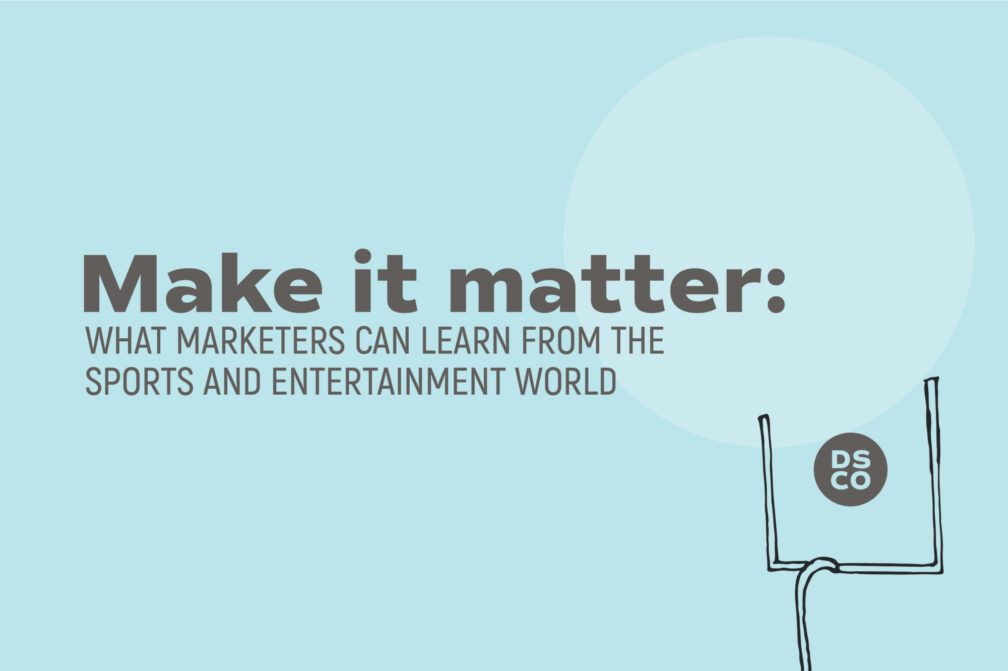Blog
Marketing

Make it matter: What marketers can learn from the sports and entertainment world
Boil down the goal of marketing into a three-word sentence and you’d be hard-pressed to do better than this: Make it matter. Your message. Your product or service. Your content or your CTA. Whatever and however a brand puts itself out into the world, it must find a way to matter to its audience.
And that’s what makes marketing so hard.
It’s one thing to make a big deal out of events like the Super Bowl or a red-carpet affair—spectacles that already matter to massive audiences. But the reality of marketing is that most of the time, we’re dealing with much smaller audiences and far less enthusiasm. Product launches, thought-leadership pieces, grand openings, mergers and acquisitions—these things don’t register on the same interest scale as a movie premiere or concert. With a few tactics pulled from the sports and entertainment marketing playbook, brands can leave an impression on the people who matter the most.
Here are three scenarios where marketers can learn from the sports and entertainment world, and then scale and apply to their own brand strategies.
MAKE IT INTRIGUING | The NFL Schedule Release
One of the biggest days of the NFL’s offseason is the release of the upcoming season’s schedule. No actual game is played. No player is traded. It’s literally just a list of games for 20-some weeks. Still, the league doesn’t waste the opportunity to satisfy fans who are frothing at the mouth to talk football. Rather than dump it out in one big reveal, the NFL trickles out information leading up to the full schedule release in May, right on the heels of the annual NFL draft. By the time the schedules are announced, most fans know exactly which teams they’ll be playing, just not the dates and times.
Takeaway: Look at the down times of your marketing season and identify ways to inject energy from the more exciting times to come. Tease what’s going to happen and provide enough detail to gain interest without giving it all away. The NFL schedule doesn’t matter in May any more than it does in March or June, unless that’s when it’s being announced. This can also be an excellent tool to get early feedback from your most engaged audiences.
MAKE IT EXCLUSIVE | Mulan
With movie theaters shut down due to the pandemic, Disney (and the rest of the movie-making world) needed a new way to manage distribution of its latest and greatest. To do that, Disney leveraged the classic marketing tactic of exclusivity to drive interest in its live-action reboot of Mulan. But more importantly, it drove sales in the newly created Premier Access aspect of its Disney+ streaming service. While there was some blowback related to the added cost to something customers were already paying for, exclusivity is a catalyst for interest—particularly for the most engaged and loyal customers. Focusing on that die-hard subset of the potential audience not only encouraged them to pay extra, but it also increased the anticipation toward the movie for those who weren’t willing to do so. This meant that when the movie was available for Disney+ subscribers, the interest to watch was still high.
Takeaway: Reward your most loyal customers with exclusive access. You may not have a pay-to-play platform like Disney does, but you can use it to cultivate other forms of currency like email addresses or user-generated content. The added payoff is that your loyal customers build even stronger bonds to the brand while those who were “good” customers now have an excuse to go deeper than before.
MAKE IT AN EVENT | Selection Sunday
The first NCAA Tournament bracket challenges surfaced in 1977 and the trend quickly caught on with expanded media coverage. Almost as quickly, the NCAA and its media partner, CBS, realized they had an opportunity to turn the bracket announcement into a kickoff event. Selection Sunday was officially introduced in 1982, with CBS (and a young Brent Musburger) teaming up with the NCAA to fill in the bracket on national TV, complete with cameras beaming in from college campuses for instant reactions. Nearly 40 years later, Selection Sunday takes two hours to do what could be done in two minutes—release the brackets—and no college basketball fans are complaining.
Takeaway: Your audiences are telling you what they’re interested in, so listen. Take that information and turn it into a celebration of what they love most and invite them to actively participate. In this case, the bracket is just the beginning for fans who then fill it out to see how many they can get right. Give your audience what they need and the means to do what they want with it.
These concepts may feel like they only belong to brands with millions of fans, but that’s simply not true. If your brand (or even just your industry) has “fans” at all, you can leverage and amplify their interest in similar ways. Unless, of course, you think it doesn’t matter.
Paul Gangarossa
Paul Gangarossa is a marketing strategist who is focused on identifying insights that pave the way for successful campaigns. Contact him at paul_gangarossa@dixonschwabl.com.